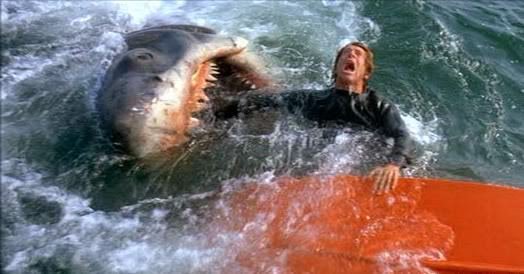Why the 'Estuary scene' is the most important shark attack in Jaws
The term thalassophobia might not summon a chill up your spine the same way, say, arachnophobia would, but chances are you probably have it to some degree: It’s a fear of deep bodies of water--the sea, for instance. That particular vast, deep expanse holds myriad natural wonders, but, instinctively and sensibly, there’s something speaking within oneself that urges caution and, in the case of thalassophobia, transforms into a sort of terror. Such subject matter makes for great fodder in the film industry, and no other film has captured and cultivated that fear like 1975’s Jaws.
Much has been made about the inability of the mechanical shark, affectionately named Bruce, to work when called upon, which prompted Steven Spielberg and his crew to creatively keep the fish more or less hidden until the big reveal during Brody’s chumming duty--but hold on for just a second, if you please. The “bigger boat” scene wasn’t the first time you saw the shark, was it? Those who know the movie well already know the answer: Our first true look at Jaws came during the estuary scene, a sequence that perfectly primes the audience for not only the sweeping surface breach that backs Scheider into the boat cabin, but the final, bloody confrontation with Quint.
It’s my belief that this estuary sequence is the creepiest, most versatile, and most pivotal kill in the film. It’s unique in execution in comparison to the rest of the attacks, and accelerates the stakes of the film by expertly utilizing a combination of some of our greatest innate fears; in doing so, it assists wonderfully in fending off a lull in the middle of the running time, and illustrates a textbook example of how to create centrifugal force that carries the audience onward.
Part I
I won’t bog you down with the details of Jaws’ box office success and continuing endurance as a veritable adventure/horror gold standard, and its place in our culture holds steadfastly enough to where even people who hate horror films can hardly separate the film from the word shark. It’s enough for the purposes of this article to carry in what knowledge you already have--its impact on our ability to trapse into the ocean and have a good time. Only three feet deep, you say? Who gives a shit--your back’s still facing the shore. For that reason alone, it’s also undoubtedly the most effective animal attack movie ever created. We, as modern people, have no fear of predation (aside from by other humans) out in the world; even in the forests near our respective homes, being targeted by a bear or large cat is enough to make regional or even national news. Without going severely out of our elements (e.g. deep rainforests, swamps), deep water remains a spot where the secular are at their most untenable, and Jaws thumps that raw nerve time and again.
While it does indeed hold themes of overcoming fear, the dangers of capitalism, and good ole comradery, the meat and potatoes of the viewing of an animal attack movie are the parts where the animal...attacks. Jaws upended the approach to these sorts of scenes and completely rewrote the book on how to conduct them in a spine-tingling manner. What’s more, and certainly a less-discussed aspect of the movie, is how unique each attack is; we’re never entirely treated to the same bag of tricks twice, the root cause being that each death has something to say--a weight upon the narrative.
Going forward, I’ll analyze the keynote shark attacks in the movie: Chrissie Watkins, Alex Kintner, Quint, and, finally, the Estuary Victim.
Part II
Let’s start with Chrissie Watkins. I’m sure you need no reminder, as it’s one of the most memorable openings in film history, but try to pour over the details in your mind. We get to know her just a little through a few spoken lines: She’s obviously sweet-natured, likely free-spirited, definitely horny and wanting to make the water where it happens. The attack was a night-time ambush, wherein there’s no definitive evidence that she even gets a look at precisely what has a hold of her, nor do we as viewers. Her endeavor wasn’t borne out of carelessness--she had no reason to believe that such a danger would be lurking in those waters--and so her demise officially establishes the sort of danger that the citizens of Amity are in. By all rights, though, she’s in the open ocean, literally naked and alone, and Hooper would later hypothesize that Bruce is a rogue shark. At this point in time, without the benefit of knowing you’re watching a two-hour movie about a giant shark that terrorizes a New England beach, one could simply assume that Chrissie found herself on the business end of an astronomically rare string of bad luck. As the sea returns to an eerie quiet following her death, the message is clear: You’re no longer safe in the ocean.
The next casualty, Alex Kitner, turns the intensity knob up a notch as the victim is now--you guessed it--a child. The film wastes no time in letting kids know that they, too, are on the menu and, meanwhile, the parents have the freedom to simulate their own anguish were they in Mrs. Kitner’s position. It’s the first time we actually see the shark draw blood, juxtaposed against that yellow float, and it’s now established that, while before you were simply just no longer safe in the ocean...now you’re no longer safe even with people around. Our view of the shark is limited to some thrashing fins, courtesy of some bad behind-the-scenes luck with shot continuity (we were originally supposed to see the shark emerge and take the boy in plain sight). Finally, we must consider if we think that Alex perceived what got him. It was yet another ambush attack, and we observed a shot of the boy gurgling as he was being dragged into the depths, but, again, based on what we’re shown, there’s no evidence that he saw what got him.
As I mentioned earlier, we’re going to skip over the Estuary Victim and go on to the main-event kill--Quint. It’s the death with the most spectacle; he’s our “man’s man” who literally goes down fighting. We must acknowledge here that Quint is technically eaten on the boat, and, while it’s positively bone-chilling to think about a shark making landfall to come after you (and definitely Junji Ito territory), the feeling of helplessness/hopelessness isn’t as marked, since, at the very least, you’re on “solid” ground.
Quint absolutely knows what’s got him, it’s categorizable as an ambush (stands to reason that no one expected the shark to jump in the fucking boat), and, in terms of narrative, it’s the culmination of the man-versus-nature theme, the fulfillment of Quint’s prophecy the night before down in the cabin, spotlights that a mere tough-guy attitude, or even a superior sea-faring one, won’t win this fight, and ups the suspense as it trims down the crew and sets the stage for a winner-take-all showdown.
Now, before we continue, let’s review:
Each kill was an ambush
No evidence to suggest that Chrissie nor Alex saw the shark
The one person to see the shark attacking him, Quint, was not in the water
Alex was killed in plain sight of the public
The estuary sequence is the centerpiece of the film, full-stop. It’s the point of no return for both Brody and Mayor Vaughn; it’s the nadir of our protagonist’s journey and affords the viewer with two of the most unsettling visuals in cinema to cement the point, which we’ll get to in just a second.
This attack, unlike the ones before it or the one ahead of it, pushes all of the chips to the middle of the table in terms of primal fears. First off, recall why we’re in the estuary. It’s because it was deemed safe, right? It’s the “pond” that’s not directly the beach, and said shark would have to swim by scores of yummy Fourth-of-July swimmers to get back to it--so there’s your perceived safety out of the window that’s been baseline along all of the kills (1). Next, since we know where we are, we also know that it’s a public place, and even gets an audience as the painter’s shouting draws Brody + a crowd (2). The Estuary Victim is thrown, from his element, into the water before he emerges and we get that [shudder] nightmarish glimpse of the shark gliding, just under the surface, mouth agape and grabbing the man. A quick edit then leads to his screaming first, then to an in-your-face shot of what is truly the first time we see the shark: On the surface, in the water (3) and the gentlemans knows abso-fuckin-lutely what’s eating him (4).
As the shark departs, we’re left with Brody staring toward the sea, its message, among other things, a telegraph of thalassophobia. To restate: In its execution, the Estuary Victim receives the worst of every imaginable scenario. There are people around, but there is no help to be given. You thought you were safe, but that was never the case. You were in your element, but now you’re in his. Lastly, you know what’s after you, and it’s literally picking you apart, eating you alive.
Part III
Without the benefit of the attack in the estuary, the expedition the three men embark upon still might be perceived as important and/or dangerous, but we, the viewers, needed that “point of no return”. The Estuary Victim’s demise serves as knelt knees to the belief that the shark won’t leave until it’s caught. That death, the first adult male to die on-screen, mind you, winds us up emotionally for the second/final act, where the film shifts gears and leaves Amity until the closing credits.
To compound the effect, and as if the film itself weren’t enough, the actual location where the scene was filmed remains readily accessible for a nice swim in Martha’s Vineyard over at Joseph Sylvia State Beach. Dip your toe in, or, if you’re feeling like the odds are in your favor, you can jump off of the very bridge that the shark swam under to get to the “pond”.
Were these sequences chosen in this particular order for optimum effect? To some degree, I believe so, but, like so much of this production, things just fell right into place and worked out wonderfully. In doing so, the lasting effects of Jaws, as a summation of all of the attacks, trigger us at the beach, but, to experience the full reach of its horror, look (through your fingers, at least) no further than the estuary.
Words by Nathan Helton
If you would like to write for The Daily Jaws, please visit our ‘work with us’ page
For all the latest Jaws, shark and shark movie news, follow The Daily Jaws on Instagram, Twitter and Facebook.














